Improvements of Simulating Urban Atmospheric CO2 Concentration by Coupling with Emission Height and Dynamic Boundary Layer Variations in WRF-STILT Model
Abstract
:1. Introduction
2. Materials and Methods
2.1. Observation Sites
2.2. WRF-STILT Model Configuration
2.3. The a priori CO2 Flux and CO2 Background
2.4. The Coupling of Emission Height with Dynamic PBLH Variations
2.5. Inverse Modeling: Multiplicative Scaling Factor Method
3. Results and Discussions
3.1. Comparison of Observed and Simulated CO2 Concentration Using Default and Revised Model Frameworks
3.2. Influence of a priori Emission Bias on Simulated Atmospheric CO2 Concentration
3.3. Implication of Model Improvement on Inversion Studies
4. Conclusions
Author Contributions
Funding
Institutional Review Board Statement
Informed Consent Statement
Data Availability Statement
Conflicts of Interest
References
- Satterthwaite, D. Cities’ contribution to global warming: Notes on the allocation of greenhouse gas emissions. Environ. Urban. 2008, 20, 539–549. [Google Scholar] [CrossRef] [Green Version]
- Xu, J.; Lee, X.; Xiao, W.; Cao, C.; Liu, S.; Wen, X.; Xu, J.; Zhang, Z.; Zhao, J. Interpreting the 13C/12C ratio of carbon dioxide in an urban airshed in the Yangtze River Delta, China. Atmos. Chem. Phys. 2017, 17, 3385–3399. [Google Scholar] [CrossRef] [Green Version]
- Ciais, P.; Paris, J.D.; Marland, G.; Peylin, P.; Piao, S.L.; Levin, I.; Pregger, T.; Scholz, Y.; Friedrich, R.; Rivier, L.; et al. The European carbon balance. Part 1: Fossil fuel emissions. Glob. Change Biol. 2009, 16, 1395–1408. [Google Scholar] [CrossRef]
- Gately, C.K.; Hutyra, L.R.; Wing, I.S. Cities, traffic, and CO2: A multidecadal assessment of trends, drivers, and scaling relationships. Proc. Natl. Acad. Sci. USA 2015, 112, 4999–5004. [Google Scholar] [CrossRef] [Green Version]
- Gately, C.K.; Hutyra, L.R. Large uncertainties in urban-scale carbon emissions. J. Geophys. Res. Atmos. 2017, 122, 11–242. [Google Scholar] [CrossRef]
- Boon, A.; Broquet, G.; Clifford, D.J.; Chevallier, F.; Butterfield, D.M.; Pison, I.; Ramonet, M.; Paris, J.D.; Ciais, P. Analysis of the potential of near-ground measurements of CO2 and CH4 in London, UK, for the monitoring of city-scale emissions using an atmospheric transport model. Atmos. Chem. Phys. 2016, 16, 6735–6756. [Google Scholar] [CrossRef] [Green Version]
- Staufer, J.; Broquet, G.; Bréon, F.M.; Puygrenier, V.; Chevallier, F.; Xueref-Rémy, I.; Dieudonné, E.; Lopez, M.; Schmidt, M.; Ramonet, M.; et al. The first 1-year-long estimate of the Paris region fossil fuel CO2 emissions based on atmospheric inversion. Atmos. Chem. Phys. 2016, 16, 14703–14726. [Google Scholar] [CrossRef] [Green Version]
- Turner, A.J.; Kim, J.; Fitzmaurice, H.; Newman, C.; Worthington, K.; Chan, K.; Wooldridge, P.J.; Köehler, P.; Frankenberg, C.; Cohen, R.C. Observed Impacts of COVID-19 on Urban CO2 Emissions. Geophys. Res. Lett. 2020, 47, e2020GL090037. [Google Scholar] [CrossRef]
- Hu, C.; Griffis, T.J.; Xia, L.; Xiao, W.; Liu, C.; Xiao, Q.; Huang, X.; Yang, Y.; Zhang, L.; Hou, B. Anthropogenic CO2 emission reduction during the COVID-19 pandemic in Nanchang City, China. Environ. Pollut. 2022, 309, 119767. [Google Scholar] [CrossRef]
- Geels, C.; Gloor, M.; Ciais, P.; Bousquet, P.; Peylin, P.; Vermeulen, A.T.; Dargaville, R.; Aalto, T.; Brandt, J.; Christensen, J.H.; et al. Comparing atmospheric transport models for future regional inversions over Europe—Part 1: Mapping the atmospheric CO2 signals. Atmos. Chem. Phys. 2007, 7, 3461–3479. [Google Scholar] [CrossRef]
- Brunner, D.; Kuhlmann, G.; Marshall, J.; Clément, V.; Fuhrer, O.; Broquet, G.; Löscher, A.; Meijer, Y. Accounting for the vertical distribution of emissions in atmospheric CO2 simulations. Atmos. Chem. Phys. 2019, 19, 4541–4559. [Google Scholar] [CrossRef] [Green Version]
- Wang, Y.; Wang, X.; Wang, K.; Chevallier, F.; Zhu, D.; Lian, J.; He, Y.; Tian, H.; Li, J.; Zhu, J.; et al. The size of the land carbon sink in China. Nature 2022, 603, E7–E9. [Google Scholar] [CrossRef] [PubMed]
- Maier, F.; Gerbig, C.; Levin, I.; Super, I.; Marshall, J.; Hammer, S. Effects of point source emission heights in WRF–STILT: A step towards exploiting nocturnal observations in models. Geosci. Model Dev. 2022, 15, 5391–5406. [Google Scholar] [CrossRef]
- Fang, S.X.; Zhou, L.X.; Tans, P.P.; Ciais, P.; Steinbacher, M.; Xu, L.; Luan, T. In situ measurement of atmospheric CO2 at the four WMO/GAW stations in China. Atmos. Chem. Phys. 2014, 14, 2541–2554. [Google Scholar] [CrossRef] [Green Version]
- Pang, J.; Wen, X.; Sun, X. Mixing ratio and carbon isotopic composition investigation of atmospheric CO2 in Beijing, China. Sci. Total Environ. 2016, 539, 322–330. [Google Scholar] [CrossRef] [PubMed]
- Guo, J.; Zhang, J.; Yang, K.; Liao, H.; Zhang, S.; Huang, K.; Lv, Y.; Shao, J.; Yu, T.; Tong, B.; et al. Investigation of near-global daytime boundary layer height using high-resolution radiosondes: First results and comparison with ERA5, MERRA-2, JRA-55, and NCEP-2 reanalyses. Atmos. Chem. Phys. 2021, 21, 17079–17097. [Google Scholar] [CrossRef]
- Lin, J.C. A near-field tool for simulating the upstream influence of atmospheric observations: The Stochastic Time-Inverted Lagrangian Transport (STILT) model. J. Geophys. Res. 2003, 108, 4493. [Google Scholar] [CrossRef] [Green Version]
- Stein, A.F.; Draxler, R.R.; Rolph, G.D.; Stunder, B.J.B.; Cohen, M.D.; Ngan, F. NOAA’s HYSPLIT Atmospheric Transport and Dispersion Modeling System. Bull. Am. Meteorol. Soc. 2015, 96, 2059–2077. [Google Scholar] [CrossRef]
- Janssens-Maenhout, G.; Crippa, M.; Guizzardi, D.; Muntean, M.; Schaaf, E.; Dentener, F.; Bergamaschi, P.; Pagliari, V.; Olivier, J.; Peters, J.; et al. EDGAR v4.3.2 Global Atlas of the three major Greenhouse Gas Emissions for the period 1970–2012. Earth Syst. Sci. Data 2019, 11, 959–1002. [Google Scholar] [CrossRef] [Green Version]
- Crippa, M.; Solazzo, E.; Huang, G.; Guizzardi, D.; Koffi, E.; Muntean, M.; Schieberle, C.; Friedrich, R.; Janssens-Maenhout, G. High resolution temporal profiles in the emissions database for global atmospheric research. Sci. Data 2020, 7, 121. [Google Scholar] [CrossRef]
- Sargent, M.; Barrera, Y.; Nehrkorn, T.; Hutyra, L.R.; Gately, C.K.; Mckain, K.; Sweeney, C.; Hegarty, J.; Hardiman, B.; Steven, C.; et al. Anthropogenic and biogenic CO2 fluxes in the Boston urban region. Proc. Natl. Acad. Sci. USA 2018, 115, 7491–7496. [Google Scholar] [CrossRef] [PubMed] [Green Version]
- He, J.; Naik, V.; Horowitz, L.W.; Dlugokencky, E.; Thoning, K. Investigation of the global methane budget over 1980–2017 using GFDL-AM4.1. Atmos. Chem. Phys. 2020, 20, 805–827. [Google Scholar] [CrossRef] [Green Version]
- Hu, C.; Griffis, T.J.; Liu, S.; Xiao, W.; Hu, N.; Huang, W.; Yang, D.; Lee, X. Anthropogenic Methane Emission and Its Partitioning for the Yangtze River Delta Region of China. J. Geophys. Res. Biogeosci. 2019, 124, 1148–1170. [Google Scholar] [CrossRef]
- Hu, C.; Xu, J.; Liu, C.; Chen, Y.; Yang, D.; Huang, W.; Deng, L.; Liu, S.; Griffis, T.J.; Lee, X. Anthropogenic and natural controls on atmospheric δ13C-CO2 variations in the Yangtze River delta: Insights from a carbon isotope modeling framework. Atmos. Chem. Phys. 2021, 21, 10015–10037. [Google Scholar] [CrossRef]
- Hu, C.; Grif, T.J.; Millet, D.B. Top-Down Constraints on Anthropogenic CO2 Emissions Within an Agricultural-Urban Landscape. J. Geophys. Res. Atmos. 2018, 123, 4674–4694. [Google Scholar] [CrossRef]
- Kountouris, P.; Gerbig, C.; Rödenbeck, C.; Karstens, U.; Koch, T.F.; Heimann, M. Technical Note: Atmospheric CO2 inversions on the mesoscale using data-driven prior uncertainties: Methodology and system evaluation. Atmos. Chem. Phys. 2018, 18, 3027–3045. [Google Scholar] [CrossRef] [Green Version]
- Peters, W.; Jacobson, A.R.; Sweeney, C.; Andrews, A.E.; Conway, T.J.; Masarie, K.; John, B.M.; Lori MP, B.; Gabrielle, P.; Adam, I.H.; et al. An atmospheric perspective on North American carbon dioxide exchange: CarbonTracker. Proc. Natl. Acad. Sci. USA 2007, 104, 18925–18930. [Google Scholar] [CrossRef] [Green Version]
- Zhang, H.F.; Chen, B.Z.; van der Laan-Luijkx, I.T.; Chen, J.; Xu, G.; Yan, J.W.; Zhou, L.X.; Fukuyama, Y.; Tans, P.P.; Peters, W. Net terrestrial CO2 exchange over China during 2001–2010 estimated with an ensemble data assimilation system for atmospheric CO2. J. Geophys. Res. Atmos. 2014, 119, 3500–3515. [Google Scholar] [CrossRef] [Green Version]
- Zhao, C.; Andrews, A.E.; Bianco, L.; Eluszkiewicz, J.; Hirsch, A.; MacDonald, C.; Nehrkorn, T.; Fischer, M.L. Atmospheric inverse estimates of methane emissions from Central California. J. Geophys. Res. 2009, 114, D16302. [Google Scholar] [CrossRef]
- Turner, A.J.; Jacob, D.J. Balancing aggregation and smoothing errors in inverse models. Atmos. Chem. Phys. 2015, 15, 7039–7048. [Google Scholar] [CrossRef]
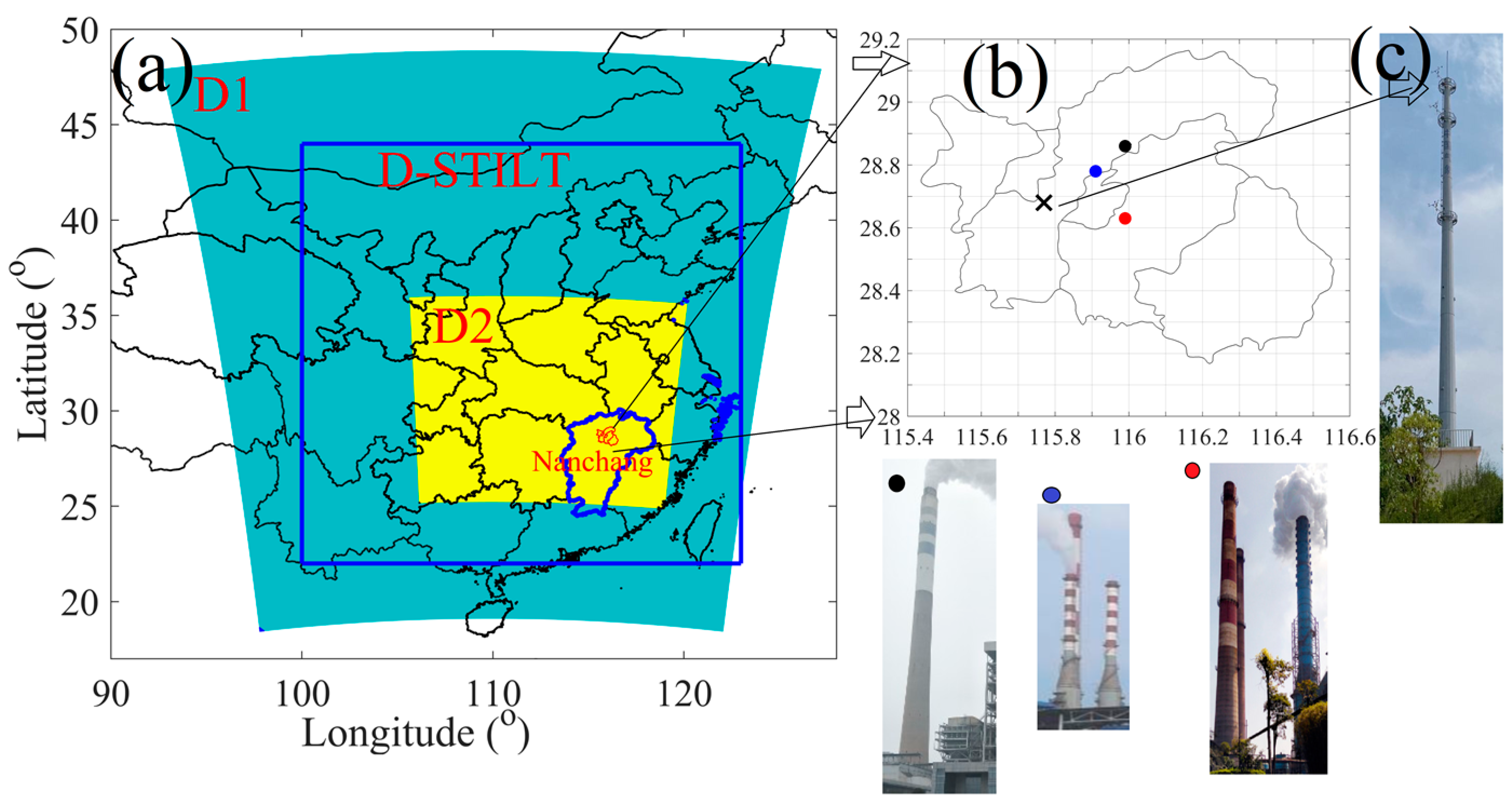
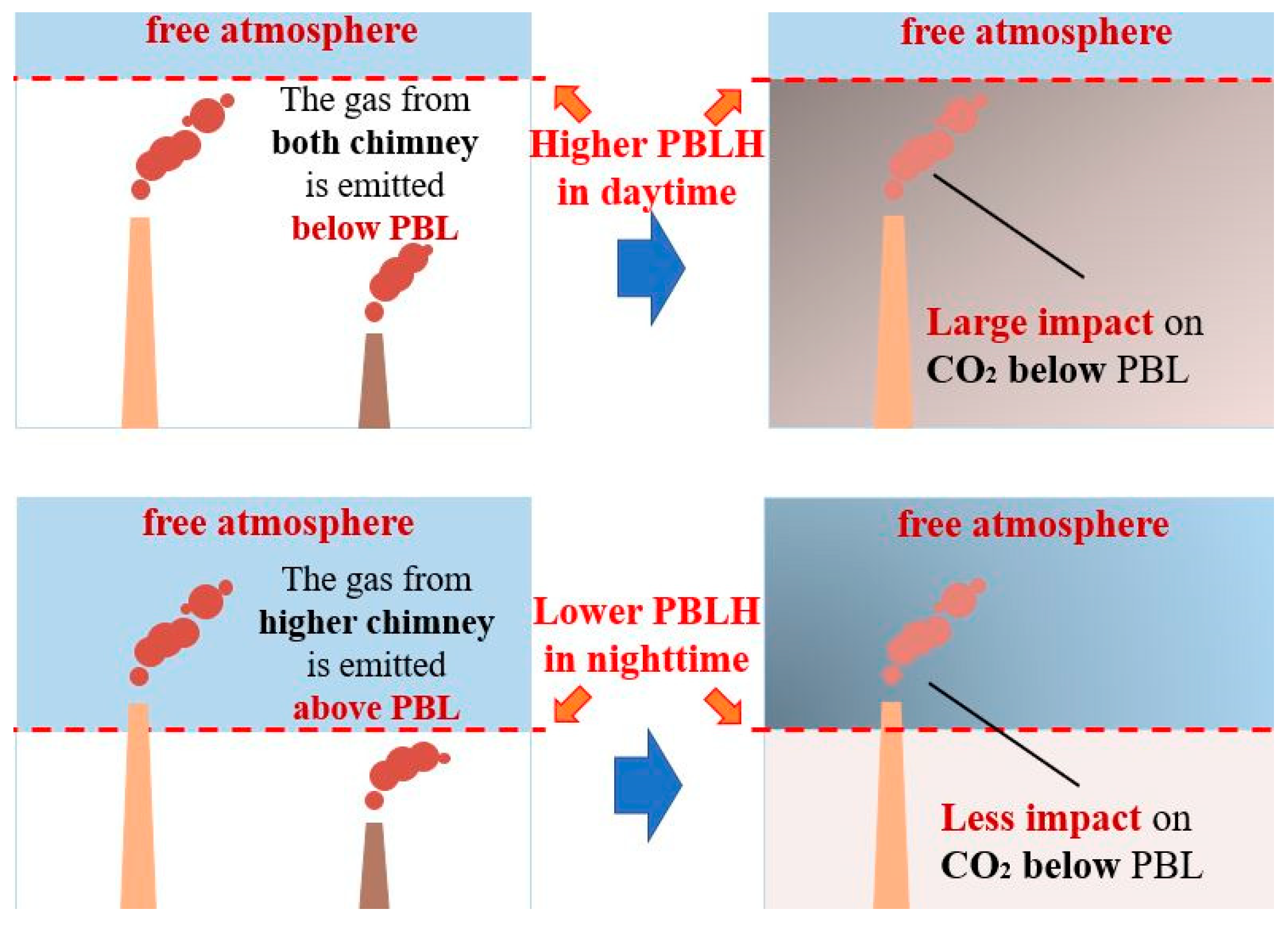


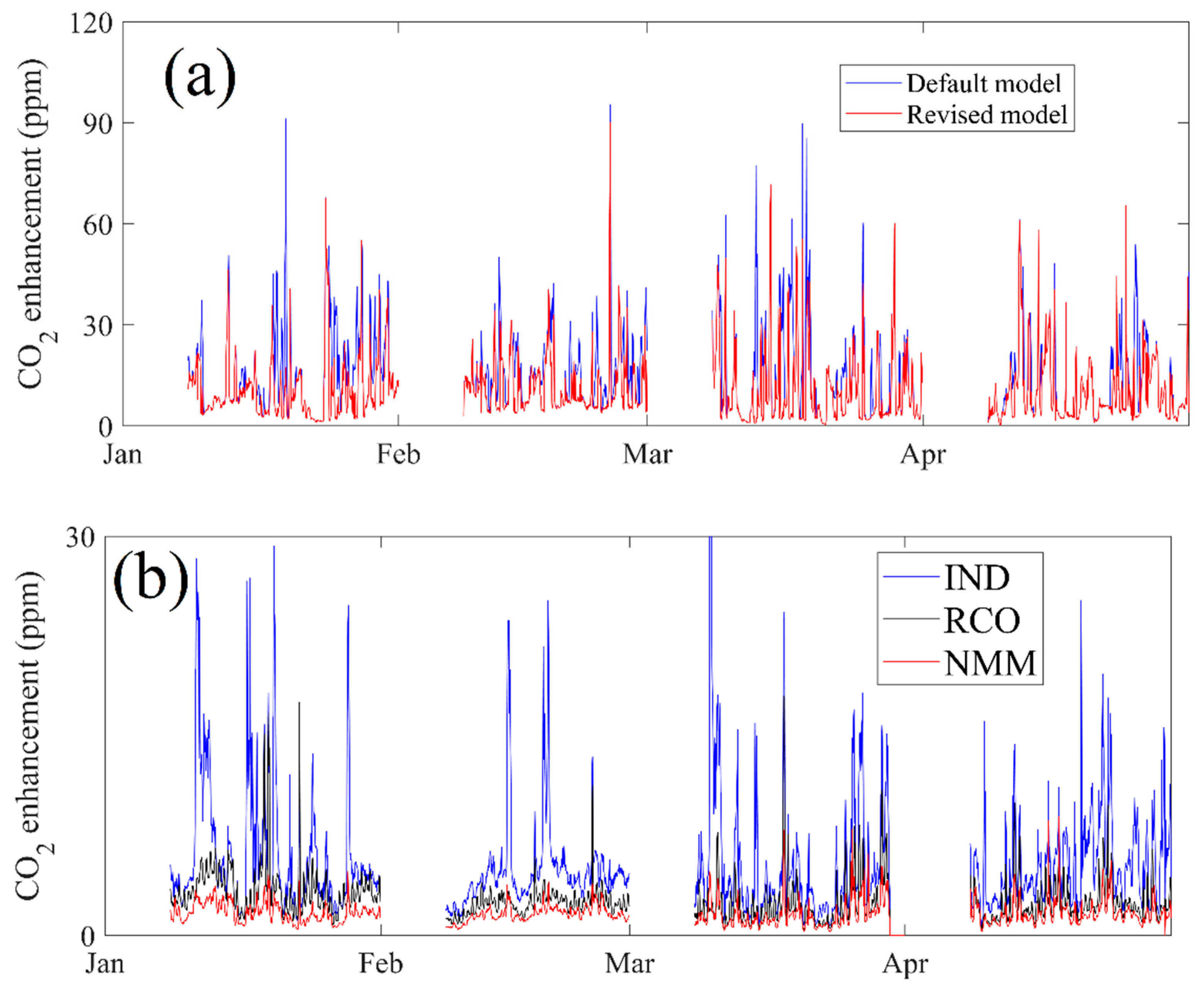
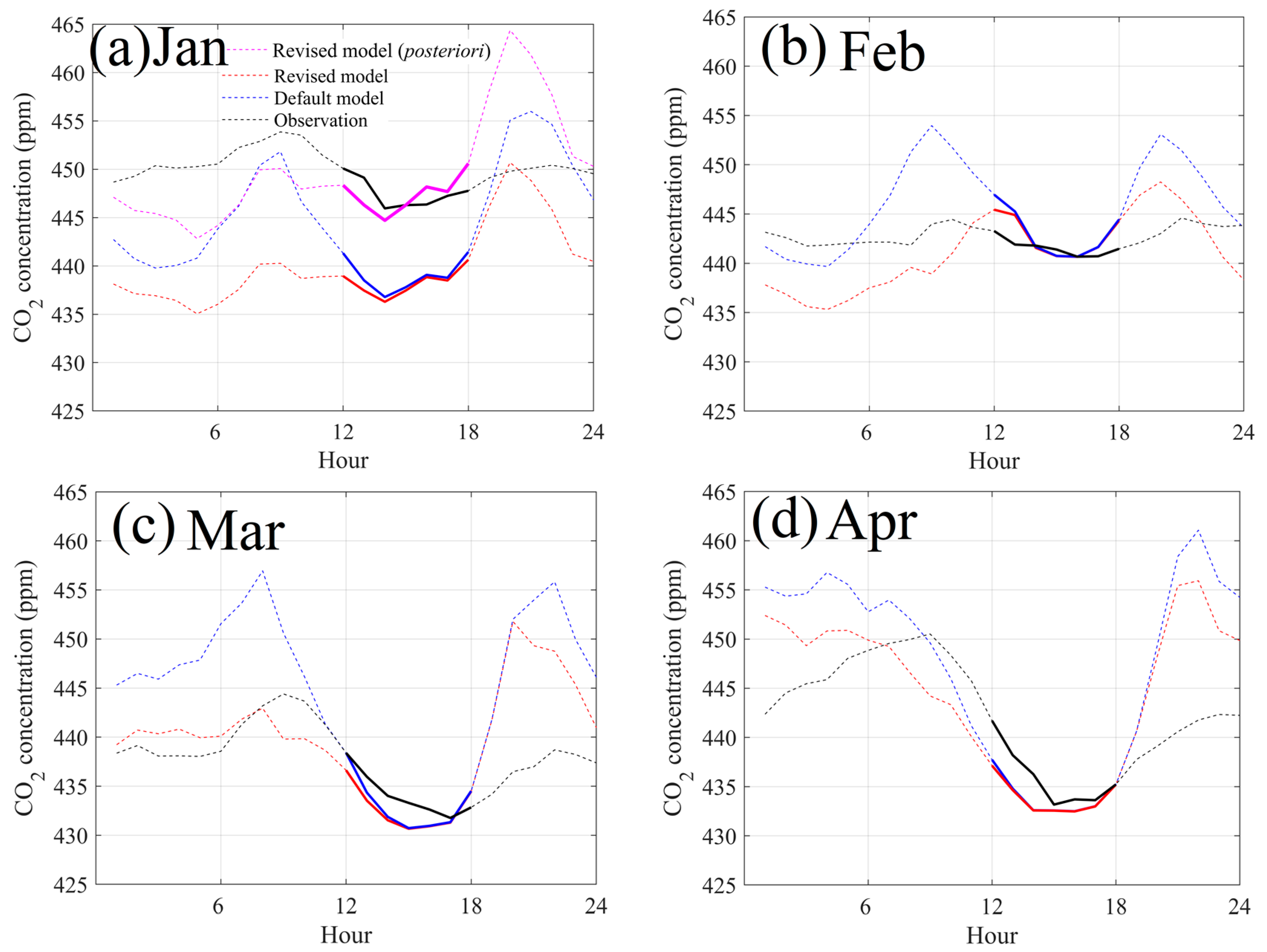

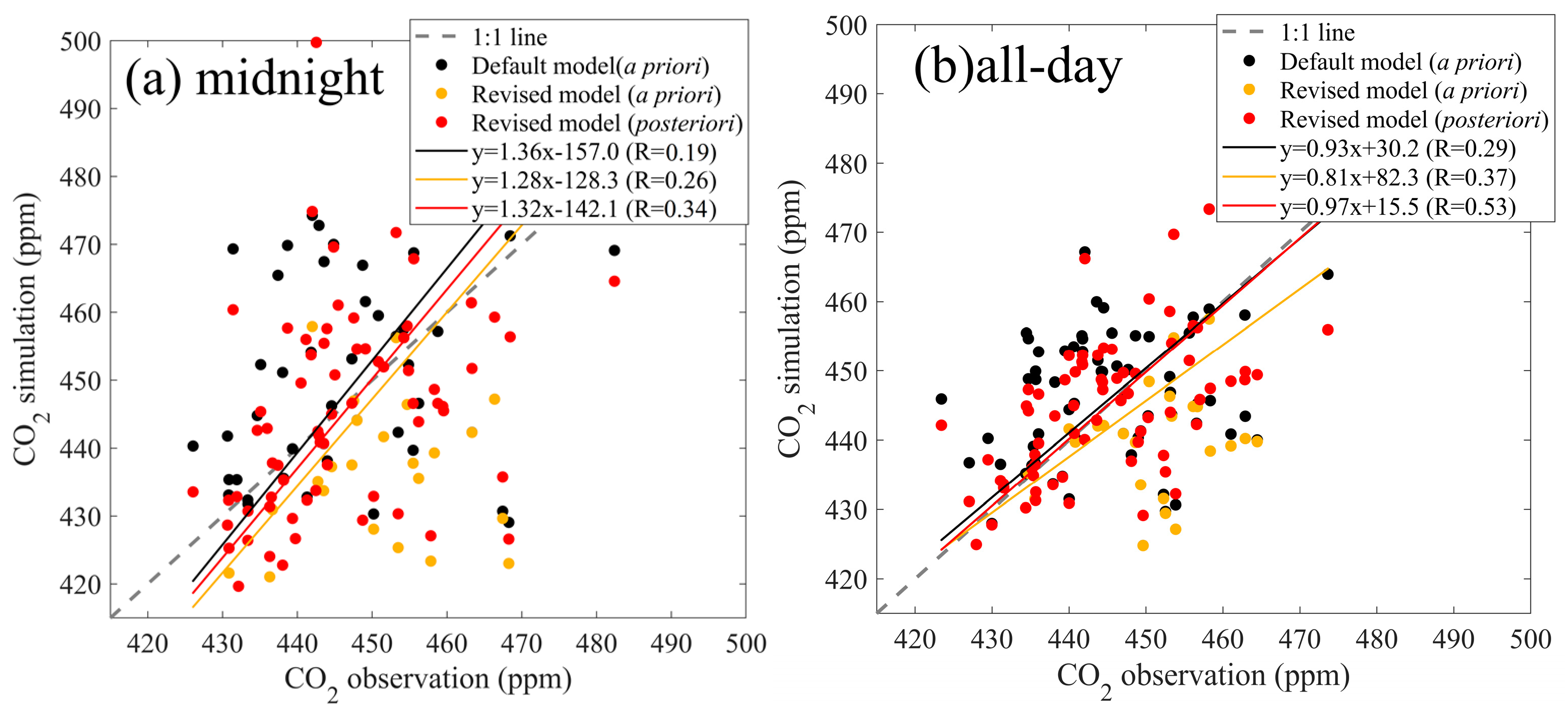
| Source Area | Jiangxi | Nanchang | Hubei | Anhui | Jiangsu | Zhejiang | Hebei | Hunan | Guangdong | Fujian | Others |
|---|---|---|---|---|---|---|---|---|---|---|---|
| January | 49.1% | 43.2% | 14.8% | 11.1% | 7.1% | 1.6% | 1.4% | 0.4% | 0.0% | 0.1% | 14.4% |
| February | 50.4% | 44.8% | 6.6% | 10.8% | 10.4% | 2.8% | 2.5% | 0.8% | 0.7% | 0.4% | 14.7% |
| March | 72.4% | 66.7% | 9.4% | 4.6% | 2.7% | 1.4% | 0.6% | 0.8% | 0.5% | 0.3% | 7.3% |
| April | 67.9% | 58.1% | 7.0% | 3.9% | 4.1% | 2.8% | 0.2% | 1.7% | 2.3% | 1.0% | 9.2% |
| RMSE | MB | R | |
|---|---|---|---|
| Default model (a priori EDGAR) | 19.2 | 1.7 | 0.17 |
| Revised model (a priori EDGAR) | 18.1 | −3.7 | 0.23 |
| Revised model (posteriori EDGAR) | 17.5 | 0.9 | 0.29 |
| Midnight | All-Day | |||||
|---|---|---|---|---|---|---|
| RMSE | MB | R | RMSE | MB | R | |
| Default model (a priori EDGAR) | 294 | 1.6 | 0.19 | 136.4 | 0.7 | 0.29 |
| Revised model (a priori EDGAR) | 263.1 | −4.0 | 0.26 | 118.9 | −3.3 | 0.37 |
| Revised model (posteriori EDGAR) | 231.9 | −1.0 | 0.34 | 92.5 | 0.1 | 0.53 |
Disclaimer/Publisher’s Note: The statements, opinions and data contained in all publications are solely those of the individual author(s) and contributor(s) and not of MDPI and/or the editor(s). MDPI and/or the editor(s) disclaim responsibility for any injury to people or property resulting from any ideas, methods, instructions or products referred to in the content. |
© 2023 by the authors. Licensee MDPI, Basel, Switzerland. This article is an open access article distributed under the terms and conditions of the Creative Commons Attribution (CC BY) license (https://creativecommons.org/licenses/by/4.0/).
Share and Cite
Peng, Y.; Hu, C.; Ai, X.; Li, Y.; Gao, L.; Liu, H.; Zhang, J.; Xiao, W. Improvements of Simulating Urban Atmospheric CO2 Concentration by Coupling with Emission Height and Dynamic Boundary Layer Variations in WRF-STILT Model. Atmosphere 2023, 14, 223. https://doi.org/10.3390/atmos14020223
Peng Y, Hu C, Ai X, Li Y, Gao L, Liu H, Zhang J, Xiao W. Improvements of Simulating Urban Atmospheric CO2 Concentration by Coupling with Emission Height and Dynamic Boundary Layer Variations in WRF-STILT Model. Atmosphere. 2023; 14(2):223. https://doi.org/10.3390/atmos14020223
Chicago/Turabian StylePeng, Yiyi, Cheng Hu, Xinyue Ai, Yuanyuan Li, Leyun Gao, Huili Liu, Junqing Zhang, and Wei Xiao. 2023. "Improvements of Simulating Urban Atmospheric CO2 Concentration by Coupling with Emission Height and Dynamic Boundary Layer Variations in WRF-STILT Model" Atmosphere 14, no. 2: 223. https://doi.org/10.3390/atmos14020223






